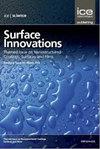An overview of green and sustainable polymeric coatings
IF 3.5
4区 材料科学
Q3 CHEMISTRY, PHYSICAL
引用次数: 0
Abstract
Synthetic polymers have to be replaced with green counterparts for sustainability needs. Green and sustainable polymeric coatings have progressively undergone development, as functional and protective materials for myriad applications ranging from packaging to biomedicine. Despite such innovative and environmental privileges, they are not adequately competitive in terms of properties to displace synthetic polymeric coatings. Functionalization of the surface and/or the bulk of the green polymeric coatings by functional groups, natural polymers, nanoparticles, crosslinking agents, anti-fouling precursors, and synthetic polymers can strengthen their properties and enlarge their performance window. However, definitions and terms related to green and sustainable coatings have not been systematically addressed. Biomass-, plant oil-, carbohydrate-, protein- and microbial-based polymeric coatings are the main classes of sustainable polymeric coatings briefly overviewed herein. The technological bottlenecks towards commercialization of sustainable coatings and films are also highlighted.绿色可持续聚合物涂料概述
为了可持续发展的需要,合成聚合物必须被绿色聚合物所取代。从包装到生物医药,绿色和可持续聚合物涂料作为功能性和保护性材料的应用日益广泛。尽管具有这样的创新和环保优势,但它们在取代合成聚合物涂料的性能方面并没有足够的竞争力。通过官能团、天然聚合物、纳米颗粒、交联剂、防污前体和合成聚合物对绿色聚合物涂料的表面和/或主体进行功能化,可以增强其性能并扩大其性能窗口。然而,与绿色和可持续涂料相关的定义和术语尚未系统地解决。本文简要介绍了生物质基、植物油基、碳水化合物基、蛋白质基和微生物基聚合物涂料的主要种类。可持续涂料和薄膜商业化的技术瓶颈也得到了强调。
本文章由计算机程序翻译,如有差异,请以英文原文为准。
求助全文
约1分钟内获得全文
求助全文
来源期刊

Surface Innovations
CHEMISTRY, PHYSICALMATERIALS SCIENCE, COAT-MATERIALS SCIENCE, COATINGS & FILMS
CiteScore
5.80
自引率
22.90%
发文量
66
期刊介绍:
The material innovations on surfaces, combined with understanding and manipulation of physics and chemistry of functional surfaces and coatings, have exploded in the past decade at an incredibly rapid pace.
Superhydrophobicity, superhydrophlicity, self-cleaning, self-healing, anti-fouling, anti-bacterial, etc., have become important fundamental topics of surface science research community driven by curiosity of physics, chemistry, and biology of interaction phenomenon at surfaces and their enormous potential in practical applications. Materials having controlled-functionality surfaces and coatings are important to the manufacturing of new products for environmental control, liquid manipulation, nanotechnological advances, biomedical engineering, pharmacy, biotechnology, and many others, and are part of the most promising technological innovations of the twenty-first century.
 求助内容:
求助内容: 应助结果提醒方式:
应助结果提醒方式:


